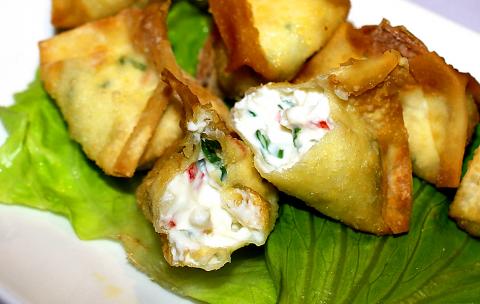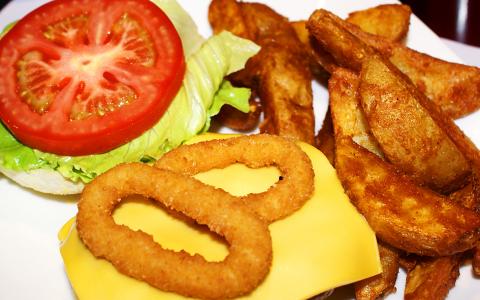The Shida area offers hamburger lovers plenty of options, with everything from higher-end authentic American-style restaurants to mom-and-pop joints that have added burgers to their menus. Enjoy Kitchen, which opened two years ago in an alley close to Taipower Building MRT Station (台電大樓捷運站) Exit 4, positions itself somewhere in the middle, with a frugally decorated but clean interior and economical prices. The restaurant bills itself as halal (food permissible according to Islamic law), so there is no bacon or alcohol on the menu.
Enjoy’s roster of 24 burgers, which come as a set meal (subtract NT$90 for a la carte), is immediately attractive to a protein lover, and the NT$50-off lunch special on weekdays makes it doubly so.
The usual burger concoctions share space with some themed according to countries, such as the Myanmar burger (NT$250) and the India burger (NT$230). Many of these, however, are just regular burgers with the addition of some item common to that country — papaya in the Thai burger (NT$230), for example, or ginger and dried bonito (skipjack tuna) in the Japanese burger (NT$230).

Photo: Noah Buchan, Taipei Times
For the brave (or foolhardy), there is the stinky tofu burger (NT$250), which my server said was a patty infused with bits of stinky tofu, and the banana burger (NT$230). Not feeling particularly courageous, I ordered the onion ring burger (NT$230), which came with wedge fries (onion rings, salad or corn chips are also available) and bottomless cola.
For a place that deems itself an expert on burgers, Enjoy served up a little disappointment. The veggies were fresh and plentiful, the patty was toothsome and grilled to my specifications, and the use of an English muffin rather than the usual bun was an interesting spin on an American standard, but the processed cheese wasn’t melted and the two smallish onion rings tasted like they came from a package. I suspect much of the cook’s energy went into preparing the wedge fries, which were lightly seasoned, crispy, and served in a generous portion.
Enjoy also has a selection of salads, of which the spicy green papaya (NT$140) is notable for its citrusy flavor and hot finish. I also tried the “cream dumplings” (NT$120), eight deep-fried pastry wrap morsels containing cream cheese, imitation crab, milk, green onion and honey. Though the crab is fake (which is not specified on the menu), the creamy and textured filling was a pleasure.

Photo: Noah Buchan, Taipei Times
Enjoy Kitchen’s relatively cheap prices and wide selection of burgers make it an attractive place to visit. Those hankering for a more authentic American burger, however, are better off heading to one of the many other burger joints in the area.

In the March 9 edition of the Taipei Times a piece by Ninon Godefroy ran with the headine “The quiet, gentle rhythm of Taiwan.” It started with the line “Taiwan is a small, humble place. There is no Eiffel Tower, no pyramids — no singular attraction that draws the world’s attention.” I laughed out loud at that. This was out of no disrespect for the author or the piece, which made some interesting analogies and good points about how both Din Tai Fung’s and Taiwan Semiconductor Manufacturing Co’s (TSMC, 台積電) meticulous attention to detail and quality are not quite up to

April 21 to April 27 Hsieh Er’s (謝娥) political fortunes were rising fast after she got out of jail and joined the Chinese Nationalist Party (KMT) in December 1945. Not only did she hold key positions in various committees, she was elected the only woman on the Taipei City Council and headed to Nanjing in 1946 as the sole Taiwanese female representative to the National Constituent Assembly. With the support of first lady Soong May-ling (宋美齡), she started the Taipei Women’s Association and Taiwan Provincial Women’s Association, where she

Chinese Nationalist Party (KMT) Chairman Eric Chu (朱立倫) hatched a bold plan to charge forward and seize the initiative when he held a protest in front of the Taipei City Prosecutors’ Office. Though risky, because illegal, its success would help tackle at least six problems facing both himself and the KMT. What he did not see coming was Taipei Mayor Chiang Wan-an (將萬安) tripping him up out of the gate. In spite of Chu being the most consequential and successful KMT chairman since the early 2010s — arguably saving the party from financial ruin and restoring its electoral viability —

It is one of the more remarkable facts of Taiwan history that it was never occupied or claimed by any of the numerous kingdoms of southern China — Han or otherwise — that lay just across the water from it. None of their brilliant ministers ever discovered that Taiwan was a “core interest” of the state whose annexation was “inevitable.” As Paul Kua notes in an excellent monograph laying out how the Portuguese gave Taiwan the name “Formosa,” the first Europeans to express an interest in occupying Taiwan were the Spanish. Tonio Andrade in his seminal work, How Taiwan Became Chinese,